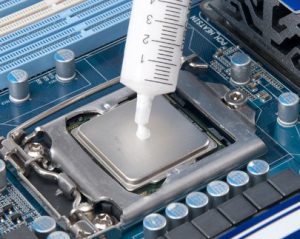Every modern person uses a desktop computer or laptop. However, not everyone is able to bring the device themselves, as they say, to their senses when it starts to overheat, although in 90% of cases it is enough to simply change the thermal paste. This very thick substance contributes to improved cooling.
If you decide to change it yourself, then when choosing a thermal paste, you must very carefully study all the properties and read the instructions. Otherwise, you can not only fail to help, but also harm your PC. To avoid such problems, we suggest figuring out how to choose the right thermal paste for your computer or laptop processor and how to quickly and efficiently replace it.
Content
Purpose and application of thermal paste

How a laptop or computer works are complex because they involve many interconnected parts. Parts of them tend to heat up, so timely and correct cooling largely determines the normal uninterrupted functioning of the laptop. Components prone to overheating are the processor and discrete graphics card (if available). The radiator is responsible for their cooling, which connects the parts to each other. Due to the operation of the cooler, its temperature is reduced, and the computer does not experience overheating. In the system unit of a desktop computer, everything is a little different. A cooler is installed on the processor (video card) itself, in which there is a small plate that absorbs heat.
However, without thermal paste, the above effect will not exist, since it is it that draws increased overheating from the processor and video card and transfers it to the laptop radiator or cooler of the corresponding part. It is simply necessary to use this paste, otherwise the temperature will not drop, and the processor of a computer or laptop will simply burn out.
Thermal paste selection criteria

Not every thermal paste is capable of improving the performance of the PC cooling system, so its selection must be taken very responsibly. There are many different cooling pastes available, but not all will work with a laptop or computer. Therefore, before choosing a thermal paste, you need to familiarize yourself with a number of criteria that will help you find a quality option.
- Thermal conductivity. Any thermal paste has the main purpose of absorbing heat and transferring it to a cooler or radiator, so this indicator is, of course, key. The higher it is, the better the cooling.
- Thermal stability. It is equally important for thermal paste to withstand high temperature differences, since otherwise increased wear is formed, which contributes to the deterioration of the quality of parts.
- Resistance. The heating temperatures of the processor and video card can be incredibly high, and the ability to compensate for such overheating is provided only by thermal paste that is very susceptible to temperature changes.
- Plastic. This property is more subjective, since the ability of the paste to easily spread across the chipset area depends directly on the efforts of the computer owner (or the person performing this simple operation).
- Composition.The properties listed above largely depend on the composition of the thermal paste. Expensive options include copper, tungsten, silver and other metals, while cheaper formulations are based on polydimethylsiloxane fluid with a small addition of metal powders (most often zinc).
Replacing and Applying Thermal Paste in the CPU Cooling System

Naturally, having decided on this "operation", everyone begins to think about how to replace the thermal paste on the processor in a laptop or computer without having any special skills and knowledge. In fact, the hardest part to reach is where you want to apply the substance. To do this, you need to disassemble the chipset cooling system.
Each PC model is individual, therefore, either written instructions or a video tutorial will help to successfully disconnect (and then assemble) all the components. It is best to use the latter, because due to clarity, you can perform all the actions most accurately without damaging a single detail.
Each processor has either a heatsink (laptop) or a cooler (system unit). After disconnecting them, the chipset itself appears with a slight gray coating over the entire area, as well as on the sides. Before applying the paste to the processor, gently scrape off the old thermal paste. It is best to do this with a plastic spatula that comes with the purchased kit. If not, you can remove it with your hands or a wooden stick.
Before distributing, you need to determine how much thermal paste to apply to the processor. As a rule, a small pea is required, although with increased sizes of parts (on older computers and laptops), you can squeeze out a little more. You need to smear the paste carefully and evenly over the entire area of the chipset so that it does not overheat later. After application, you need to connect all the components in the reverse order and assemble the PC.
Remember that the applied layer of paste must not be too thick, otherwise the effect of heat transfer from the processor to the heatsink will slow down and the processor may be damaged!
The best manufacturers of thermal paste for laptops
It is quite difficult to choose the best thermal paste for a laptop, as there are several manufacturers whose products meet the highest requirements. Each of them offers reliable protection of the processor and video card from overheating, has excellent properties and high-quality composition. The championship in the ranking of the best manufacturers of thermal pastes in 2020 is shared by two companies:
- Titan
- Gigabyte
Their cooling pastes have the best thermal conductivity (from 8 to 9 W / mK), and the temperatures that are subject to them range from -55 to 200 degrees.
Pastes from Aero, Arctic Cooling, Geil and Fanner perform well. They are slightly cheaper than Titan and Gigabyte, but their properties differ slightly. Surprisingly, there are also good domestic options. For example, KPT-8. You can buy this thermal paste at a relatively low price, but it will work no worse than the options above.
The best manufacturers of thermal paste for computers
The question of which company of thermal paste is better to choose for a PC is solved quite simply due to the relatively low competition among manufacturers. In fact, two options are suitable:
- Zalman
- Koolance
The first has a slightly lower thermal conductivity (4.1 W / mK versus 4.5 W / mK), but this is compensated by a high temperature range (from -45 to 150 degrees versus -40 and 145 degrees). Both versions of thermal paste are sold in the form of syringes of various sizes, so everyone can choose the appropriate tube if necessary (even the smallest will last for a long time). There will be no problems with distribution over the chipset due to the fact that the kit comes with a small plastic spatula.
Conclusion
High-quality thermal paste is a prerequisite for efficient operation of a laptop or computer. It is imperative that the components are cooled in a timely manner, so changing the paste on time is extremely important.Having figured out how to choose a high-quality thermal paste for a laptop or PC processor and how to change it correctly, you can be sure that your favorite device will not overheat.



